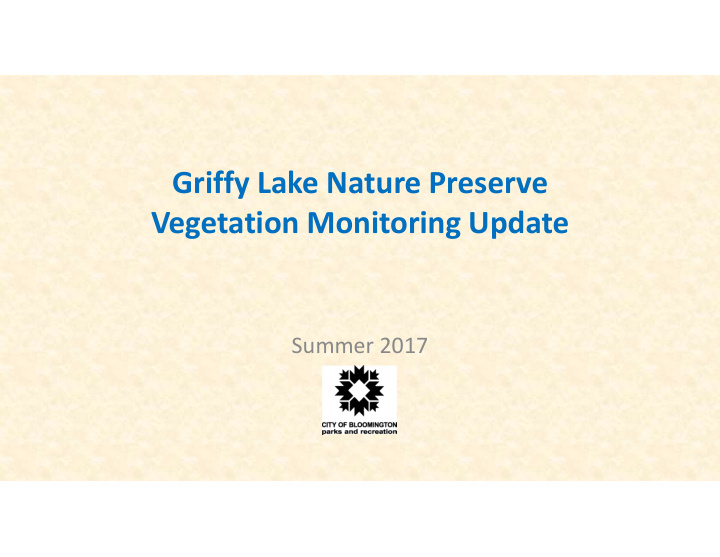



Griffy Lake Nature Preserve Vegetation Monitoring Update Summer 2017
History of Deer Population in Indiana • early 1900s: Essentially all deer in Indiana killed by hunting and habitat destruction • 1930s: Deer reintroduced to state • 1950s: Populations re-established and modern hunting programs begun • 1990s - present: Historic high deer populations • Forest vegetation in Bloomington area more affected by deer than other nearby areas
Causes of High Deer Populations Primary causes of deer increase – improved forage from agriculture & towns 12 • • – elimination of natural predators • • • 10 • • • • • Deer per square km • • • – increase in edge habitat preferred by deer 8 • • • • • • • • • • • • • • 6 • • • • • • • • • • – supplemental feeding 4 – warmer winters 2 – hunters (and regulations) often favor bucks 0 1960 1965 1970 1975 1980 1985 1990 1995 2000 – Reduction in number of hunters Deer populations in Wisconsin from 1960 to 2000 Images from Fairfield County, Conn. Deer Management Alliance. www.deeralliance.com
Effects of Deer on Ecological Communities Study of Effects of Deer on Indiana State Parks by George Parker and Chris Webster in 1996 • Unhunted state parks had – fewer tree seedlings and shrubs – lower % cover of herbaceous species – higher cover of unpalatable species • Since state park hunts began, there has been a dramatic increase in understory forest diversity and plant coverage • In Wisconsin, several state parks without hunting lost over 50% of plant species
Effects of Deer Browsing on a Forest Herb Large-flowered Trillium, Trillium grandiflorum Fraction in Each Life Stage Population Growth Rate increasing population Reproductive Value declining population Average % Herbivory % Herbivory Knight, Caswell, and Kalisz. 2009. Forest Ecology and Management 257: 1095.
Griffy Lake Nature Preserve Comparative Vegetation Data 2017 Data collected by Peter Slothower 28 April – 12 May 2017 Data summarized by Angie Shelton, 18 May 2017
All six species have fewer flowering plants at GLNP. See detailed view of less common species on next slide.
All six species have fewer Subset of species flowering on previous graph plants at GLNP. Graph shows only the less common species from previous slide.
Largest plants of all six species were shorter at GLNP than other sites.
Why Survey Spring Ephemerals? • Very susceptible to deer browsing: first fresh green food after winter • Most species are long-lived perennials that have to get several years old before they have energy to make flowers • If plants are browsed, they may grow back smaller next year and delay flowering. • This can lead to extinction of local populations.
Indicator Species for Deer in Indiana Height of these species is a good indicator of deer browsing intensity in Indiana (Webster and Parker 1996) Average Height (cm) control fenced jack-in-the-pulpit 10.6 14.0 sweet cicely - 14.7 white baneberry 10.3 20.5
Effect of Deer on Plant Height After protection from deer, plants grow taller. Taller plants have greater chance of reproduction.
Ecological Effects of Deer Overpopulation • increases plant invasions (Vavra et al 2007, Baiser et al 2008) • reduces size of eaten and uneaten plants (Heckel et al 2010) • increases soil compaction (Heckel et al 2010) • inhibits natural succession and tree regeneration (Côté et al 2004, Rooney & Waller 2003) • causes shift to alternative community types (Webster et al 2008, Augustine et al 1998, Waller & Alverson 1997) • reduces habitat for birds, small mammals, other animals (McShea & Rappole 2000) • reduces food resources for other herbivores (Côté et al 2004) • reduces litter depth (Heckel et al 2010) • increases bare soil � erosion and sediment runoff • increases disease in deer populations (Côté et al 2004) • makes humans cranky (countless citizens)
• Researcher in IU Biology Department • Work for IU Research and Teaching Preserve • Map of Preserve Sites/ Map of Griffy ownership • ERAC chair • Advisor for Deer Task Force
Griffy Woods Deer Density Locations of Pellet Hwy 37 Count Surveys 350 9 – 95 per plot 300 Nashville average pellet piles/ha 45/46 250 Hwy 46 200 3 rd St 150 Hwy 446 100 2 – 5 0 – 6 50 per plot per plot 0 Griffy Woods Moores Creek Lilly Dickey Woods Moores Lilly Griffy Approximately 11 times more Creek Woods Dickey pellet piles at Griffy Woods than Woods at two other nearby Preserves. * Plot Area = 1664 m 2 . 1 ha = 10,000 m 2 .
Effects on Woody Plants open forest plot fenced forest plot 28 woody plants 204 woody plants 7 species 21 species
Vegetative Structure 20 Unfenced P < 0.0001 Japanese stiltgrass is more # Touches by Vegetation 16 Fenced abundant in controls than exclosures. 12 Suggests interaction between P = 0.0003 deer and invasive species. 8 P = 0.0211 4 Plot invaded by Stiltgrass 300 # Touches by Vegetation Control 0 250 20 60 140 Exclosure 200 Height (cm) 150 100 Vegetation is significantly more abundant inside exclosures at all heights within 50 browse range. Data collected after 2-3 0 20 60 140 years of fencing. Height Above Ground (cm)
Tree and Shrub Seedlings 40 P = 0.0047 Outside exclosures: Control 35 - No native trees are Exclosure 30 regenerating 25 - Dominated by invasives # new seedlings unpalatable and unpalatable species 20 invasive 15 native trees 10 5 0 pawpaw multiflora rose honeysuckle viburnum ash spicebush privet hickory sassafras beech grape musclewood sugar maple barberry tree or shrub species
Recommend
More recommend